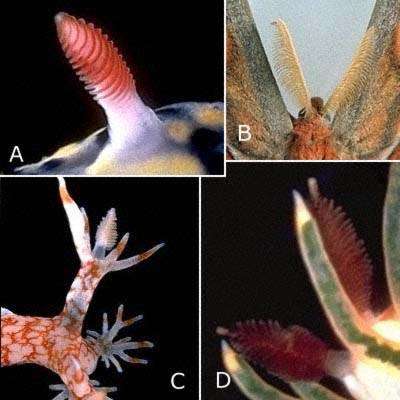
Rhinophore in nudibranchs
PHOTO
Different shaped rhinophores.
A. DORIDINA
Hypselodoris infucta
B. INSECTA
Moth antennae
C. DENDRONOTINA
Bornella stellifer
D. AEOLIDINA
Aeolidia helicochorda
E. AEOLIDINA
Spurilla australis
F. ARMININA
Dematobranchus sp.
G. AEOLIDINA
Cratena sp.
H. DENDRONOTINA
Marianina rosea
I. DORIDINA
Ceratosoma trilobata
PHOTOS: Bill Rudman.
The word RHINOPHORE is made from two classical Greek words rhino = nose, and phore = carrier, and is a reference to the function of the rhinophores as an organ of "smell". We smell scents and odours with our nose, which has special receptors to sense the chemical molecules in the air. In nudibranchs, and other marine animals, the same sort of chemicals are dissolved in the sea water. In many Sea Slugs this is how they find their food. Scent receptors work better when there is a lot of surface area to test for the chemicals. Many of the rhinophore shapes, illustrated here, show the different ways a simple rod-like rhinophore (G) can be modified to provide a much greater surface area by developing horizontal flaps or lamellae (A,C,D,I), or papillae (E,H), or vertical folds (F). Compare these rhinophores with the feathery antennae of a large moth (B) which needs to detect odours so that it can find the flowers it feeds on and a partner for breeding.
Nudibranchs have a pair of rhinophores at the front end of their bodies. Because of their "worm-like" shape, rhinophores are in constant danger of being nibbled by fish. To protect them from such damage, most are able to withdraw into a pocket beneath the skin. Often there is a raised collar or sheath around each pocket which can be clamped shut when the slug is disturbed.
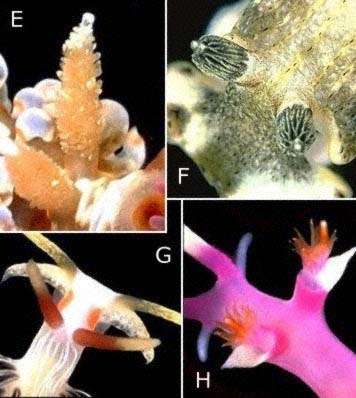
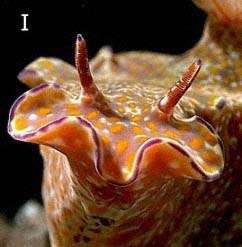
Rudman, W.B., 1999 (March 25) Rhinophore in nudibranchs. [In] Sea Slug Forum. Australian Museum, Sydney. Available from http://www.seaslugforum.net/find/rhinonud
Related messages
Re: Glossodoris atromarginata feeding [1]
June 28, 2007
From: Philip Cromwell
Concerning message #20018:
Dear Bill and Richard,
In the first picture of the message, it appears that the rhinophores have rotated and the anterior line is now pointing to the left side of the animal (the right side of the photo). Is this my imagination or are rhinophores directional? Obviously this is the first time I've noticed this.
Thanks,
Phil
chiron42@sbcglobal.net
Cromwell, P. A., 2007 (Jun 28) Re: Glossodoris atromarginata feeding [1]. [Message in] Sea Slug Forum. Australian Museum, Sydney. Available from http://www.seaslugforum.net/find/20079Dear Phil,
Thanks for noticing that. Yes they are able to swivel their rhinophores around like this - a bit like a dog or rabbit moving its ears to get a more precise fix on a sound. I guess when your 'view' of the world is esentially based on a palette of chemicals, any means of getting a better 'view' is valuable.
Best wishes,
Bill Rudman
Slug's noses
April 25, 2003
From: Laura Ruiz
How many noses, if any, does a slug have
Laura Ruiz
lauraprincess01@hotmail.com
Dear Laura,
The simple answer is that sea slugs don't have noses but that doesn't tell you much. We use out nose for breathing and smelling things. Perhaps you want to know what they use instead of a nose? Since they live in the sea, sea slugs get the oxygen they need by extracting it from the water. For this they use their gills, or in some cases their skin is also thin enough for oxygen molecules to pass through so it also acts as a gill. We use out nose to send air to our lungs for breathing. Our lungs have very thin ducts and folds which remove oxygen from the air in the very same way as a slugs gills. So I guess for breathing you could say the slug's gills replace the nose.
The other main function of our nose is for smelling. Many slugs, have a pair of head tentacles called rhinophores which smell things in the water. Have a look at the rhinophore page for more information. Have a look at the Nudibranch Head Page for some more information on slug sense organs.
Best wishes,
Bill Rudman
Can sea slugs pull in their rhinophores ?
October 19, 2002
From: Sabine Noack
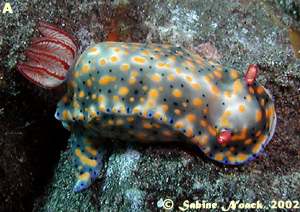
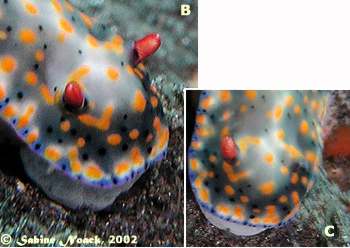
Dear Bill.
The following pictures of a Hypselodoris infucata were taken within a few seconds. The slug was sitting on one of the black stones in shallow water close to the edge of a deeper area of black sand, there were 2 Hypselodoris nigrostriata 2 stones further away, and there was a bit of a surge moving it's gills.
On pictures A (13:39:52) and B (13:40:32) both rhinophores are clearly visible, on picture C (13:40:50) one is missing (possibly pulled in). I didn't touch the animal or manipulate the photos.
Location: Ulami North, Tulamben, East Bali, Indonesia.
Date: 28.9.2002 13:40
Depth: 4 m
Length: 4 cm
Sabine Noack
dive@snoack.de
Noack, S., 2002 (Oct 19) Can sea slugs pull in their rhinophores ?. [Message in] Sea Slug Forum. Australian Museum, Sydney. Available from http://www.seaslugforum.net/find/8228Dear Sabine,
The nudibranch rhinophore is a very important organ. It is the animal's smelling organ, enabling it to sense food chemicals in the water. Being able to retract it quickly is an important defence mechanism. In some nudibranchs, such as in Hypselodoris, the rhinophores have special pockets into which they can be withdrawn.
Thanks for these useful photos,
Bill Rudman
